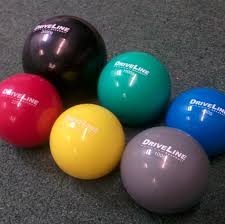
While weighted balls are typically debated in the context of high intent throwing (or pulldowns), they also have broad applications when it comes to reinforcing good movement patterns, command work, and warmup/recovery. About 90% of our weighted ball usage at Driveline is focused on warmup/recovery, both of these can fit into a regular practice plan in ten minutes or less.
Introducing load gradually in a warmup is a great way to add work capacity and reinforce good movement patterns. This is why our weighted ball warmup is typically done exclusively with overload balls (more than six ounces). Recent research coming from ASMI has found that throwing overload balls- even when thrown at high intent- results in less torque on the shoulder and elbow than throwing a baseball.
Obviously, we have more comprehensive warmup and recovery routines that we implement in-house, but here’s one that can work well for teams that are just beginning to integrate weighted ball throwing into their warm-ups:
- Start with soft-tissue work- rolling out the shoulder/shoulder blade with a lacrosse ball or foam roller.
- A band routine to get the shoulder and muscles around the shoulder blade warm- we use J-Bands.
- There are two ways to use weighted balls for warm-up: PlyoCare (sand filled) balls with our constraint drills, and using weighted baseballs for long toss. Our PlyoCare drill breaks down important pieces of the delivery, and can help to narrow an athlete’s focus and movement quality:
- Reverse Throws- strengthen the back of the shoulder. Start with the dominant arm side knee on the ground. Hold the ball near the ground, rotate the torso/arm back and throw the ball against the wall behind you. 2 sets of 10 throws with a black/green plyo ball
- Rocker Drill- Work on weight shift, coordination, and front leg strength. Start with your feet near stride length, with your front foot slightly closed off from the target. Create momentum by rocking forward and back, and then throw the ball towards a target. 1 set of 4 throws with a blue, red, yellow and gray plyo ball.
After our PlyoCare warm-up, we can move on to weighted-ball long toss. All of the weighted balls thrown during long toss should be thrown during the “extension” phase of the long toss (on the way out).
It’s important to always work down progressively from heavy-overload balls to a baseball. We recommend starting with an 11-oz ball and lightly tossing it at 50-75% effort from starting distance for a few throws. All throws at the beginning should be made with light effort and have plenty of arc on them.
Next move down to the 9-oz ball, which can be thrown at 50-75% and plenty of arc until 100 feet. After this, athletes can move down to a baseball and continue the “extension” phase of long toss. Slowing ramp up intensity and distance until the max distance of that day is reached.
We also do post-throwing active-recovery exercises for pitchers’ arms, typically with J-bands, and we use a green 1000g PlyoCare ball for upward tosses (hold ball at shoulder height, throw it upward and catch it as it begins to fall; 2 sets of 15) and side lying external rotation throws (lay on glove side, hold ball in throwing hand, rest throwing elbow on ribcage and throw ball upward, catching it as it begins to fall).
We see warm-up and recovery exercises as a vital part of our program, and these are basic exercises that can be easily introduced into a team's practice. Introducing these exercises into a practice plan can help your athletes improve their movement and better recovery from pitching.
For more information, visit
www.drivelinebaseball.com.